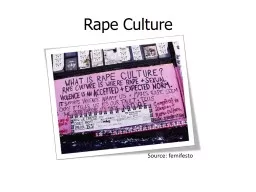PPT-ORAL PRESENTATION: RAPE STUDIES
Author : myesha-ticknor | Published Date : 2018-02-15
By K1652744 20162017 Module Criminological Research and Practice Analysed Studies RAPE OF OLDER PEOPLE IN THE UNITED KINGDOM CHALLENGING THE REAL RAPE STEREOTYPE
Presentation Embed Code
Download Presentation
Download Presentation The PPT/PDF document "ORAL PRESENTATION: RAPE STUDIES" is the property of its rightful owner. Permission is granted to download and print the materials on this website for personal, non-commercial use only, and to display it on your personal computer provided you do not modify the materials and that you retain all copyright notices contained in the materials. By downloading content from our website, you accept the terms of this agreement.
ORAL PRESENTATION: RAPE STUDIES: Transcript
Download Rules Of Document
"ORAL PRESENTATION: RAPE STUDIES"The content belongs to its owner. You may download and print it for personal use, without modification, and keep all copyright notices. By downloading, you agree to these terms.
Related Documents














